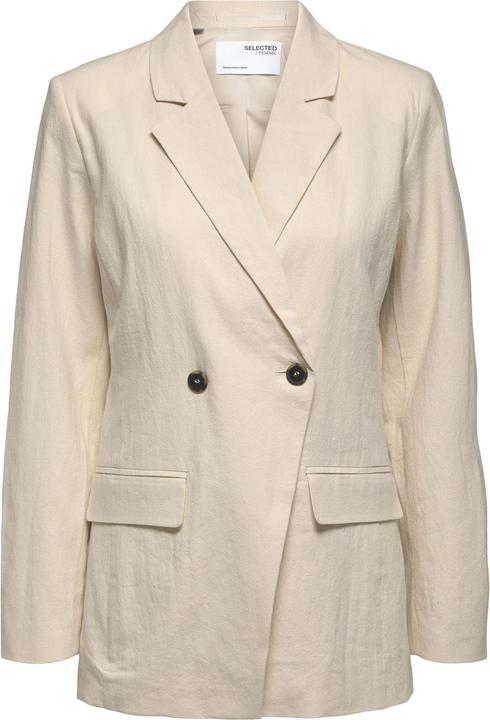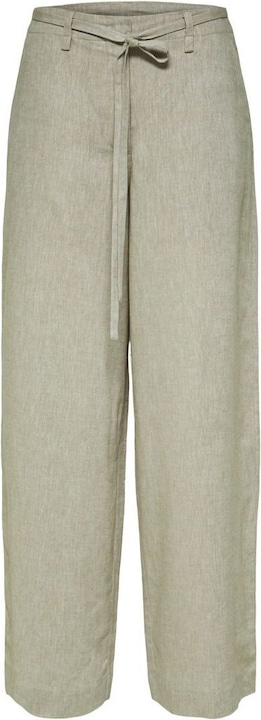

How to keep your linens lovely for longer
I don’t want to brave another summer without my favourite pair of linen trousers – which is why I take especially good care of them. Here’s what you need to watch out for when buying and caring for this natural fabric.
When the mercury’s rising, I fall into a fashion-inspired tizzy. What is it that sparks this summer outfit despair? I don’t usually feel comfortable wearing heat-friendly clothing such as skimpy skirts and shorts on a day-to-day basis. I shudder to think of my bare thighs against scratchy bus seats, or sitting in fusty office chairs that dozens of people have already sweated on. Melting away in long jeans when it’s 28 degrees, however, isn’t exactly pleasant either.
The solution to this annual dilemma prevented itself to me last year in the form of linen trousers. Yep, I know, it’s that simple. Why did it take me 26 six years to figure it out? After all, linen seems to have everything going for it as a chosen summer textile. Made from flax, the fabric is breathable, hypoallergenic, antibacterial and feels cool and airy against the skin – even when the skin is completely covered (and sweaty). Linen is also a winner when it comes to sustainability. Very little water is required to cultivate flax. Not only that, but the natural fibres are biodegradable.

Source: Instagram: @elisalevallois
Back when I was a linen novice, however, I had a few questions. I’ve since managed to answer them and sum up the most important points here. This way, you won’t need to do any googling or experimenting yourself.
Do I need to buy linens in a bigger size?
Before buying my first pair of linen trousers, I was see-sawing back and forth between two sizes: the first pair fit perfectly, the other was a little too loose. As linen can shrink by up to four per cent when it’s washed for the first time, I thought about taking the bigger size. In the end, though, I decided against it. And thank goodness I did! First of all, my trousers have barely shrunk at all. Secondly, I know from experience that linens and half-linens get looser when you’re wearing them, which compensates for the minimal shrinkage anyway.
What’s the right way to wash linen?
Theoretically, undyed, pure linen can be washed at 60 degrees, while dyed linen can be washed at 40 degrees. For me personally, the former is too risky when it comes to clothes. So that each garment lasts as long as possible, I’m a stickler for checking the care label. They usually recommend washing linen or mixed fabrics at 30 degrees.
Linen is also sensitive to friction, so I choose a gentle spin cycle or a maximum spin speed of 800, making sure not to put any hard or heavy fabrics such as denim into the machine with it. These could, after all, damage or stretch the linen. If I want to be extra careful, I turn the linens inside out and put them into a laundry bag.
And last point, I promise: since linen is highly absorbent, washing it requires a lot of water. Taking this into account, I make sure the drum is only two-thirds full.

Source: Instagram: @aideen_cd
Can linen go in the tumble drier?
I’d recommend avoiding the tumble drier at all costs. Tumble-drying your linens means you risk shrinking them or damaging the fibres. And it often results in a wrinkled mess that’s tricky to tame. With this in mind, I always let my linens air dry. I also make sure to unload the washing machine as soon as it’s done. Otherwise, stubborn creases can set it. To get the dishevelled look under control, I shake out the fabric, drape it over the drying rack and smooth it out by hand.
Does linen need to be ironed?
If you’re careful when washing and drying your linen, and it doesn’t look as if it’s been scrunched up in a drawer for years on end, you don’t necessarily have to iron it. Subtle creases are, after all, part of linen’s casual charm. In German, there’s even a term for it: «the noble wrinkle».

Source: Instagram: @matthiasgeerts

Source: Instagram: @viaemmajang
If you do want it to be smooth, turn it inside out and iron while it’s damp to fend off shiny spots and get the best results. But let’s not kid ourselves: linen is so susceptible to creases that new ones are bound to pop up again when you’re wearing it – even after just a short time. The best thing to do is simply learn to appreciate the look, or stay away from it altogether.
So when is linen really worth ironing? If your linen garment has shrunk, stiffened or become misshapen through washing, grabbing a steam iron will help whip it back into shape.
Header image: Jacquemus / ImaxtreeHas endless love for shoulder pads, Stratocasters and sashimi, but a limited tolerance for bad impressions of her Eastern Swiss dialect.







